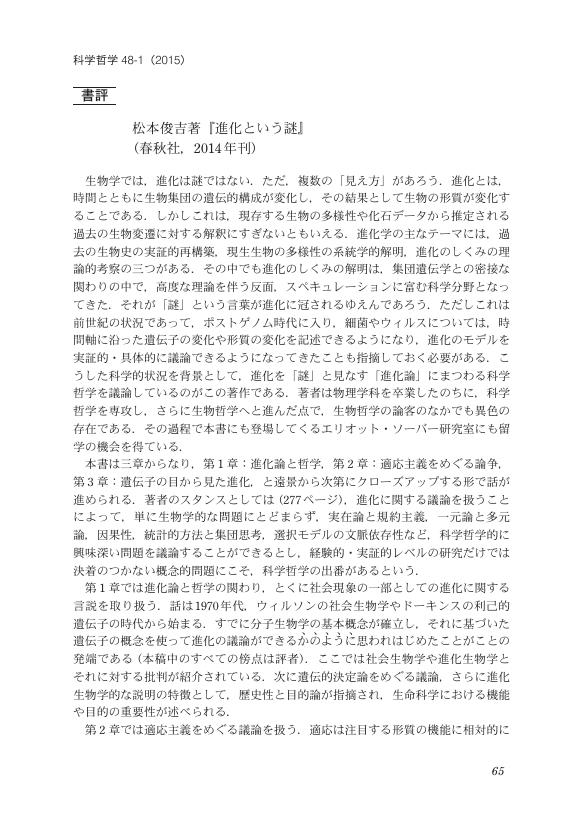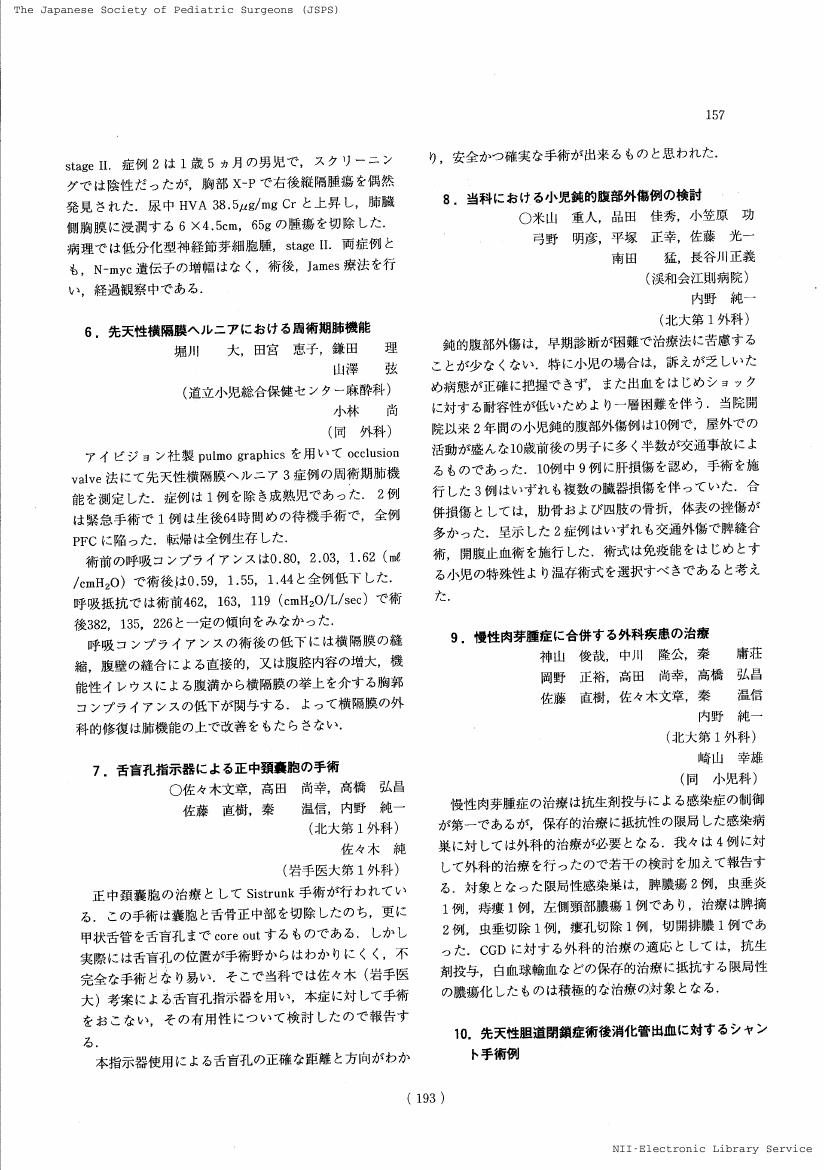3 0 0 0 OA 月食? C.D.フリードリヒによる三日月の表現をめぐって
- 著者
- 佐藤 直樹
- 出版者
- 国立西洋美術館
- 雑誌
- 国立西洋美術館研究紀要 = Journal of The National Museum of Western Art, Tokyo (ISSN:13428063)
- 巻号頁・発行日
- no.11, pp.37-50[含 英文要旨], 2007-03
- 著者
- 田中 秀則 佐藤 宏和 三浦 広志 佐藤 直樹 藤本 俊郎 小西 祥朝 高橋 道 田中 俊誠
- 出版者
- 社団法人日本産科婦人科学会
- 雑誌
- 日本産科婦人科學會雜誌 (ISSN:03009165)
- 巻号頁・発行日
- vol.57, no.2, 2005-02-01
- 著者
- 佐藤 直樹
- 出版者
- 関東社会学会
- 雑誌
- 年報社会学論集 (ISSN:09194363)
- 巻号頁・発行日
- no.18, pp.276-287, 2005
2 0 0 0 OA 書評
- 著者
- 佐藤 直樹 等
- 出版者
- The Philosophy of Science Society, Japan
- 雑誌
- 科学哲学 (ISSN:02893428)
- 巻号頁・発行日
- vol.48, no.1, pp.65-73, 2015-07-31 (Released:2015-11-08)
2 0 0 0 色素体細胞内共生説の源流 : メレシコフスキー論文の紹介と再評価
- 著者
- 佐藤 直樹
- 出版者
- 日本光合成研究会
- 雑誌
- 光合成研究 = News letter (ISSN:18842852)
- 巻号頁・発行日
- vol.26, no.2, pp.106-117, 2016-08
2 0 0 0 OA 主観的違法論と現象学的刑法学 : 西台満『主観的違法性の理論』(世界書院)をめぐって
- 著者
- 佐藤 直樹
- 出版者
- 九州工業大学情報工学部
- 雑誌
- 九州工業大学情報工学部紀要. 人間科学篇 = Bulletin of the Faculty of Computer Science and Systems Engineering, Kyushu Institute of Technology. Human sciences (ISSN:13439405)
- 巻号頁・発行日
- vol.11, pp.122-136, 1998-03-25
2 0 0 0 OA 19世紀ローマにおける外国人芸術家の活動と交流に関する包括的研究
1 0 0 0 OA 物理量や単位の表記について(教科書の記述を考える 14)
- 著者
- 佐藤 直樹
- 出版者
- 公益社団法人 日本化学会
- 雑誌
- 化学と教育 (ISSN:03862151)
- 巻号頁・発行日
- vol.46, no.9, pp.569-573, 1998-09-20 (Released:2017-07-11)
- 参考文献数
- 2
- 被引用文献数
- 1
自然科学では量の関係を重んじる。その自然科学の柱の一本をなす化学でも, 物理量や単位などの表記はけっして枝葉末節の問題ではなく, ときには理解の本質に深く関わってくる。おもに「化学IB」の教科書をそんな目で見ると, どんどん使っていくべき国際単位系(SI)への対応が実質的にはほとんど図られていないように思える。ここはぜひ, 単位系の技術的な側面だけにとらわれることなく, むしろその思想や基礎概念について勘案しながら手直しを始める必要があろう。このように考える立場から広い議論が湧くことを期待して, 教科書中で目にとまった気になる表記や記述について, その具体例のいくつかを指摘したい。
1 0 0 0 OA 若年者大腸癌の病態および治療成績
- 著者
- 西田 修 佐野 文男 佐藤 直樹 五十嵐 究 木村 純 葛西 洋一
- 出版者
- 一般社団法人 日本消化器外科学会
- 雑誌
- 日本消化器外科学会雑誌 (ISSN:03869768)
- 巻号頁・発行日
- vol.17, no.9, pp.1758-1762, 1984 (Released:2011-03-02)
- 参考文献数
- 17
- 被引用文献数
- 2 3
1968年から1982年までに当科で経験した40歳未満の若年者大腸癌23例の病態および治療成績に検討を加えた. 若年者大腸癌は全大腸癌の9.7%で, 平均病悩期間は4.5ヵ月, 腫瘍長径は6.6cmと高年者より発育が速い. 組織学的には低分化腺癌 (17%) と粘液癌 (33%) の頻度が高い. n (+) は若年者49%, 高年者38%, V (+) は若年者48%, 高年者32%, ly (+) は若年者47%, 高年者37%と, いずれも若年者の頻度が高い. 臨床症状は若年者に腹痛および肛門痛が39%と多い. 若年者大腸癌の再発率は60%, 5生率44%とその成績は不良で, 特に, 肝転移再発が38.5%と高いため, 門脈内への化学療法が望まれる.
1 0 0 0 OA Type 2 : 慢性心腎症候群
- 著者
- 佐藤 直樹
- 出版者
- 公益財団法人 日本心臓財団
- 雑誌
- 心臓 (ISSN:05864488)
- 巻号頁・発行日
- vol.47, no.5, pp.542-545, 2015 (Released:2016-05-16)
- 参考文献数
- 6
- 著者
- 佐藤 直樹
- 出版者
- 19世紀学学会
- 雑誌
- 19世紀学研究 (ISSN:18827578)
- 巻号頁・発行日
- no.8, pp.77-97, 2014-03
In the 19th century there were many colonies of foreign artists in Rome, but we have limited documents about their international exchanges. The purpose of this article is to find some traces of visual cross-references between international artists there, analyzing especially the works by a German landscape painter, Johann Christian Reinhart. At his time, Rome was occupied by Napoleon and the French Academy had established a branch school at the Villa Medici in the center of Rome. In spite of the French rule, not only political but also cultural, the overall majority of the artists operating in Rome was German. Reinhart, the leading figure of the German artists, had rediscovered Tivoli, Castelli Romani and some picturesque areas around Rome, of which he likely got information from French artists in Rome. With these new subjects he created a realistic and heroic engraving series titled "Mahlerisch-radierten Prospecte aus Italien" (1792-99). The series inspired international young artists to go sketching in the surroundings of Rome, and it was originally planned by Reinhart as a collaboration with two French artists whose names are not mentioned in any of his letters, because he recognized that the French had advanced in the outdoor painting and he wished to learn its realistic representation. In the end he could not work together with them, but he developed his picturesque engravings in his own new style. Reinhart painted "Four Views from Villa Malta" (1831-35) in tempera for King Ludwig I. of Bavaria. Villa Malta was the king's residence in Rome and he wanted to bring the unforgettable city views as large paintings back to Munich. Reinhart's challenge was to reproduce a precise panorama, the so-called Veduta. For these panoramic views he might have used a new optical instrument, the Camera Lucida, which had been invented in England in 1786 and was used by British landscape painters for tracing the reflected scene through a prism. I suppose that Reinhart had gained the information about this tool from his artistic milieu, for example the French engraver Noël-François Bertrand and the British painter Samuel Bellin, who were also active in Rome in the same period. The similarity of their optic angles cannot be imagined without them using the instrument. My research has just started, therefore I would like to study further the possibility of the three artists having shared the Camera Lucida in Rome.
- 著者
- 井上 美保 井口 隆文 川田 あゆみ 佐藤 直樹 渡辺 敏郎 段 武夫 田辺 創一 武藤 徳男
- 出版者
- 公益財団法人 日本醸造協会
- 雑誌
- 日本醸造協会誌 (ISSN:09147314)
- 巻号頁・発行日
- vol.103, no.6, pp.499-504, 2008
大麦醗酵エキスと赤紫蘇エキスを主成分とした大麦赤紫蘇飲料の摂取がスギおよびヒノキ花粉症患者の症状に及ぼす影響について検討した。被験者は, スギ花粉症の症状を有し, 血液検査でスギRASTスコァーが陽性と判定された25人を対象とし, スギ花粉が飛散する前から大麦赤紫蘇飲料を飲用するA群と花粉が飛散してから飲用を開始するB群の2群に分けて実施した。くしゃみと鼻水 (鼻をかんだ回数) のスコアーでは, スギの花粉が飛散するとB群のスコアーが常に高値を示し, 症状が悪化した。一方で鼻詰まりと目のかゆみに関しては両群ともに差は認められなかった。鼻症状の総合的判断である鼻Symptom ScoreとSymptom Medication Scoreでは, スギの花粉飛散後, B群が高値を示し, A群は軽症であった。大麦赤紫蘇飲料は, 大麦醗酵エキスを主成分とする飲料であり, 大麦赤紫蘇飲料による花粉症症状の軽減効果は, 主として大麦醗酵エキス成分による効果と考えられた。
- 著者
- 藤原 誠 関根 康介 山本 義治 阿部 知子 佐藤 直樹 伊藤 竜一
- 出版者
- 日本植物生理学会
- 雑誌
- 日本植物生理学会年会およびシンポジウム 講演要旨集
- 巻号頁・発行日
- vol.2010, pp.362, 2010
葉緑体は植物細胞内で対称二分裂によって増殖する。葉緑体分裂の初期イベントはチューブリン様タンパク質FtsZが重合して出来るZリング形成であると考えられており、我々はこれまでにZリング形成の空間的制御にはストロマタンパク質MinDとMinEの活性のバランスが重要であることを示してきた。しかし、FtsZタンパク質が葉緑体内の特定の位置で凝集、重合し、さらに高次リング構造を形成する<I>in vivo</I>の過程については、未だ不明な点が多い。今回、我々はFtsZ1とGFPとの融合タンパク質(FtsZ1-GFP)を発現するシロイヌナズナ<I>MinE</I>(<I>AtMinE1</I>)過剰発現体及び変異体を用いて、生体葉緑体内におけるFtsZ1の構造と挙動を詳細に観察した。<br> 経時観察の結果、<I>AtMinE1</I>過剰発現体及び変異体いずれにおいても、ドット状及び短いフィラメント状のFtsZ1構造が存在し、無秩序な運動性を示すことが明らかになった。短いフィラメント状のFtsZはしばしばドット状のFtsZから伸張しており、別のフィラメントに組み込まれ太いフィラメントを形成した。<I>AtMinE1</I>過剰発現体では伸張した葉緑体を巻く螺旋状のFtsZが観察されたほか、<I>atminE1</I>変異体では巨大葉緑体のストロマ中に浮かぶ直径2μm以下のリングが検出された。
1 0 0 0 OA 高速飛行実証(HSFD)フェーズ1の実施体制
- 著者
- 種村 利春 末松 俊二 佐藤 直樹 HSFDフェーズ1 NAL/NASDA実験隊 NAL/NASDA HOPE研究共同チーム Tanemura Toshiharu Suematsu Shunji Sato Naoki NAL/NASDA HSFD-Phase 1 Experiment Team NAL/NASDA HOPE Team
- 出版者
- 航空宇宙技術研究所
- 雑誌
- 航空宇宙技術研究所資料 = Technical Memorandum of National Aerospace Laboratory (ISSN:1347460X)
- 巻号頁・発行日
- vol.780, 2003-08
航空宇宙技術研究所(NAL)と宇宙開発事業団(NASDA)は将来の再使用宇宙輸送システム研究開発の一環として有翼往還機の進入・着陸システムの評価・実証および自律飛行技術の蓄積を目的とした高速飛行実証フェーズ1、飛行実験を2002年8月から12月にキリバス共和国クリスマス島において実施した。本報告はこの飛行実験実施に伴うNAL、NASDA、メーカーおよびキリバス共和国関係者を含めた実施協力体制および実験実施環境整備などについてまとめたものである。
1 0 0 0 OA 9. 慢性肉芽腫症に合併する外科疾患の治療(第 42 回日本小児外科学会北海道地方会)
- 著者
- 神山 俊哉 中川 隆公 秦 庸荘 岡野 正裕 高田 尚幸 高橋 弘昌 佐藤 直樹 佐々木 文章 秦 温信 内野 純一 崎山 幸雄
- 出版者
- 特定非営利活動法人 日本小児外科学会
- 雑誌
- 日本小児外科学会雑誌 (ISSN:0288609X)
- 巻号頁・発行日
- vol.27, no.1, pp.157, 1991-02-20 (Released:2017-01-01)
1 0 0 0 OA RCTは絶対的エビデンスである
- 著者
- 石原 嗣郎 佐藤 直樹
- 雑誌
- 第46回日本集中治療医学会学術集会
- 巻号頁・発行日
- 2019-02-04
現在、生理学的根拠・知識、権威に基づく医療、個人的な経験によるものではなく、患者背景、医師の技量、エビデンスを3つの柱とした、いわゆる根拠に基づく医療(evidence based medicine, EBM)を行うことが多くの場面で求められる。そのEBMを実践する上で、エビデンスのピラミッドからも見て取れるように、ランダム化比較試験が最もエビデンスレベルの高い手法であり、この手法のみが交絡因子を排除することが可能である。つまり、薬物やある治療法がある集団で効果があるかどうかを検証する方法としてはRCTが最も優れた手法であると言える。しかし、RCTの問題点として、コストの問題、外的妥当性の限界など、様々である。ただ、EBMに基づく医療を掲げるのであれば、RCTにおける対象群やプロコール、解析方法などに対して批判的吟味を行った上で実臨床につなげる必要があることは自明のことであり、RCTから得られた結果をどう使うかも、やはりEBMに基づく診療と言える。
1 0 0 0 OA 木質系資材の堆肥化時間短縮に関する研究-木酢液及び廃糖蜜を発酵促進剤として利用した場合
- 著者
- 佐藤 直樹 ロイ キンシュック
- 出版者
- 一般社団法人 環境情報科学センター
- 雑誌
- 環境情報科学論文集 Vol.24(第24回環境研究発表会)
- 巻号頁・発行日
- pp.161-166, 2010 (Released:2011-08-12)
木質系資材は堆肥化過程において時間がかかるという問題が指摘されている。これまでに堆肥化装置の利用や大規模な堆肥化により時間の短縮をする研究が行われているが,普及という点で課題が残る。そのため本研究では,木材チップと落ち葉に,発酵鶏糞,米糠,菜種油粕を副資材として加えた原料に,発酵促進剤として木酢液や廃糖蜜を利用することで,小規模で機械を使わない木質系資材の堆肥化時間短縮の有用性を検討した。その結果,堆積物内の温度が堆肥化に必要な温度まで上昇した。また,発酵促進剤を加える事により温度が維持された。廃糖蜜を利用した区は,3ケ月でC/N比測定試験,4ヶ月で幼植物試験において完熟したと判定できた。
1 0 0 0 近縁ゲノム間の遺伝子間距離構造から見えるゲノムの構造的進化
- 著者
- 佐々木 直文 佐藤 直樹
- 出版者
- 日本植物生理学会
- 雑誌
- 日本植物生理学会年会およびシンポジウム 講演要旨集
- 巻号頁・発行日
- vol.2010, pp.279, 2010
特定の種における複数の環境型を同時に解析することにより、これらのゲノムで共通な仮想的なゲノムの構造を知ることができる。これらのゲノムは、「ゲノムコア」と呼ばれるゲノム間で共通に保存されているシンテニー・ブロックと、HGTによる遺伝子の出入りが確認される、「ゲノムアイランド」領域のモザイク構造になっていることが知られているが、従来の遺伝子の隣接関係に基づく組み合わせ探索の方法では、非常に近縁であるこれらのゲノム間において、ゲノムアイランド領域とゲノムコアのゲノム上での再構成単位を同時に可視化することは難しかった。我々はこれらを可視化することが可能な「位置プロファイル法」を開発した。前回の報告では我々の開発した位置プロファイル法による、シアノバクテリア16種間の解析結果を報告した。本発表では、本手法の近縁ゲノム間の解析への活用事例として、拡張したデータセットによる手法の評価と既存法との比較、およびシアノバクテリア36種での解析と根粒形成菌の近縁種間の解析によって明らかになった、近縁ゲノム間のゲノムの構造的進化とその働きについて報告する。
1 0 0 0 S191022 カプセル回収機の誘導揚力飛行の技術課題と誘導解析
- 著者
- 近藤 義典 松本 秀一 岩田 隆敬 佐藤 直樹 今田 高峰 山本 一二三 小林 聡 本山 昇
- 出版者
- 一般社団法人 日本機械学会
- 雑誌
- 年次大会
- 巻号頁・発行日
- vol.2012, pp._S191022-1-_S191022-5, 2012
We are now studying high accuracy reentry guidance algorithms for reentry capsule. In this paper, we propose a real-time prediction guidance using numerical integration. The real-time prediction guidance is an explicit guidance law using numerical integration for range prediction during reentry flight. One of technical issues of the real-time prediction guidance using numerical integration is that navigation error and wind error lessens the navigation accuracy. Especially, errors in the last phase of reentry flight affects the navigation accuracy. So we researched that mechanism by investigating the navigation ability (ability of range adjustment) of several navigation segments.
1 0 0 0 シアノバクテリアにおけるゲノムコアのモザイク構造
- 著者
- 佐々木 直文 佐藤 直樹
- 出版者
- 日本植物生理学会
- 雑誌
- 日本植物生理学会年会およびシンポジウム 講演要旨集
- 巻号頁・発行日
- vol.2009, pp.59, 2009
近縁種ゲノムを比較するとゲノムが構造的に安定的な領域(core domain)と流動的な領域(flexible domain)が見いだされる。このうち流動的な領域はゲノムの安定的な構造の間にパッチ状に存在しており、遺伝子の水平移動(HGT)に関連した遺伝子が存在していることが知られている。一方、安定的な領域は遺伝子の並びが比較的保存され、機能的、構造的にゲノムのコアになっていることから、ゲノム再編成の解析に有効であると考えられる。本研究では、進化的に近縁である海洋性シアノバクテリア14種についてゲノム比較を行い、ゲノムの安定的な領域における遺伝子間の距離関係の情報を解析した。その結果、これらの安定的な領域が7つの仮想的な連鎖グループ(VLG)から構成されていることが明らかになった。さらに、これらのVLG間の位置関係を解析した結果、それぞれのVLGが複製開始領域(ori)を基準として決まった位置関係を持っていることが分かった。これらの結果は、ゲノムコア領域がゲノム再編成の情報を持っていることを示唆している。



